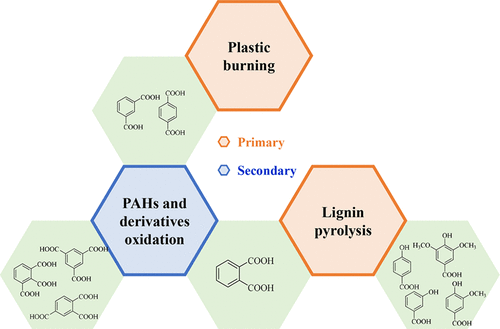当前位置:
X-MOL 学术
›
ACS Earth Space Chem.
›
论文详情
Our official English website, www.x-mol.net, welcomes your
feedback! (Note: you will need to create a separate account there.)
Abundance and Sources of Phthalic Acids, Benzene-Tricarboxylic Acids, and Phenolic Acids in PM2.5 at Urban and Suburban Sites in Southern China
ACS Earth and Space Chemistry ( IF 2.9 ) Pub Date : 2018-01-25 00:00:00 , DOI: 10.1021/acsearthspacechem.7b00131 Xiao He , X. H. Hilda Huang , Ka Shing Chow , Qiongqiong Wang , Ting Zhang 1 , Dui Wu 2 , Jian Zhen Yu 1
ACS Earth and Space Chemistry ( IF 2.9 ) Pub Date : 2018-01-25 00:00:00 , DOI: 10.1021/acsearthspacechem.7b00131 Xiao He , X. H. Hilda Huang , Ka Shing Chow , Qiongqiong Wang , Ting Zhang 1 , Dui Wu 2 , Jian Zhen Yu 1
Affiliation

|
The organic composition of airborne fine particulate matter (PM2.5, aerodynamic diameter less than 2.5 μm) at a molecular level has yet to be achieved, hindering a full understanding of the climatic impacts and health effects of PM2.5. Compounds containing aromatic rings are closely associated with optically active brown carbon and toxicologically important quinones. In this work, a group of ten aromatic organic acids including three phthalic acids, four phenolic acids, and three benzene-tricarboxylic acids (BTCAs) in PM2.5 were studied for their abundance and potential sources through quantifying their ambient concentrations at four sites in the Pearl River Delta (PRD) region in Southern China, where biomass burning and anthropogenic emissions are both significant PM sources. Average concentrations of individual aromatic acids in a total of 240 PM2.5 samples collected throughout 2012 were in the order of 0.1–20 ng/m3 with p-and o-phthalic acid being the most abundant. Interspecies correlation analysis with known PM source tracers reveals different source origins for the ten aromatic acids. The four phenolic acids, all possessing partial lignin structures, are highly correlated with levoglucosan, indicating their association with biomass burning emissions. Specific lignin tracer ratios characteristic of different types of biomass fuels (i.e., cinnamyl- to vanillyl-phenol ratio) revealed the significant influence of crop burning emissions in the PRD region. The three BTCAs have moderate correlation with sulfate but no correlation with levoglucosan, suggesting a strong association with secondary formation origins while negating a strong link with biomass burning. The three phthalic acids are moderately correlated with sulfate, levoglucosan, and a number of polycyclic aromatic hydrocarbons (PAHs), indicating multiple significant sources. This study provides a valuable data set toward establishing quantitative links between molecular composition of organic matter and the optical and toxicological properties of PM2.5 as well as assisting identification of tracers for PM2.5 sources.
更新日期:2018-01-25











































 京公网安备 11010802027423号
京公网安备 11010802027423号